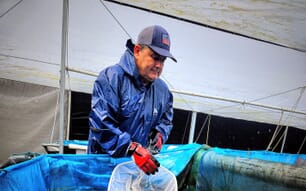Starting off the discussion, Dr George Chamberlin, President of GAA, gave an overview of the path that the disease has taken from China to Thailand.
Dr Donald Lightner, University of Arizona, was involved early on in identifying the disease, said Dr Chamberlin.
The breakthrough then came in July 2012, when one of Dr Lightner's team members, Loc Tran, found that feeding infected shrimp to healthy shrimp caused the disease.
The disease was then identified as a strain of Vibrio parahaemolyticus (VP).
The bacterial disease was found to transmit orally, colonising in the stomach where it produces toxins causing the hepatopancreas (HP) dysfunction.
Dr Chamberlin also noted that we now know that there are two phases of EMS:
- acute phase - where the toxin is released, causing damage (sloughing) to cells in the HP
- terminal phase - destruction of the HP by opportunistic VP
Discussing what may help prevent the disease, Noriaki Akazawa, Managing Director of an Agrobest shrimp farm, Malaysia, noted that he has found that p. monodon shrimp showed resistance to the disease, even though they were raised in the same ponds as p. Vannamei shrimp which did become infected.
He also identified that an environmental parameter must be involved as not all ponds had EMS outbreaks, despite them all containing VP.
The Perfect Killer
Reflecting on how EMS has effected Thailand, Robins McIntosh, Charoen Pokphand Foods (CPF), said that EMS has hit the shrimp industry hard and Thailand has lost production for three years.
Mr McIntosh described EMS as the perfect killer. The bacteria grows very fast and colonises in the stomach, producing a potent toxin.
Adding to ways in which EMS can be prevented, Mr McIntosh said that growing tilapia in the same ponds as shrimp and using freshwater/groundwater can all reduce the chance of EMS. Low salinity ponds also tend to have less problems.
Current Research
Speaking about where we are now with EMS, Dr Lightner presented to the conference the development of a PCR technique for the disease.
It is hoped that this new PCR technique will lead to diagnostic kits being distributed to EMS affected regions. PCR positive broodstock will then be destroyed or placed on a regime of approved antibiotics, in an attempt to clear them of EMS.
China a New Importer
EMS is having an effect on global markets. Gorjan Nikolik, Rabobank International, stated that EMS has caused a tradeflow shift from west to east, with China now emerging as a new net importer.
Loses are now seen in the US and EU markets where demand is contracting. Mr Nikolik said that he expects this contraction to increase as prices remain high.
Looking forward, Mr Nikolik stated that there may be new leading shrimp producing countries in the picture when the disease is solved, as countries who have been unaffected by EMS have generated capital to re-invest into improving and expanding production.
Mr McIntosh also expects the recovery of the industry to be U shaped, signifying a gradual, not sharp, increase in production. This is because it will take time to communicate and implement solutions and training with farmers.




